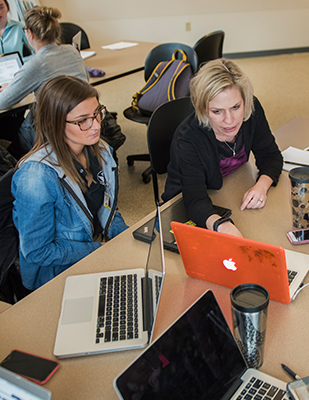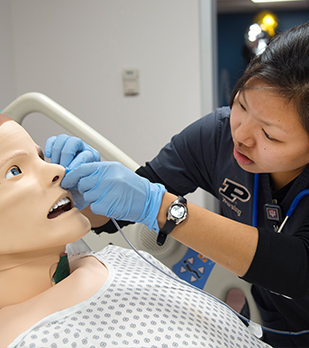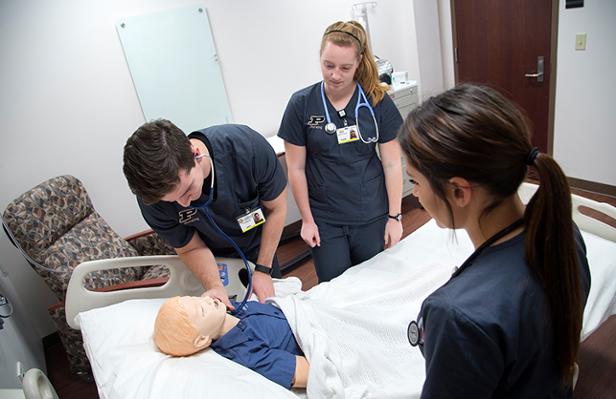Filling the gap
School of Nursing expansion looks to address nursing shortage
Written by Story by Stephanie Mouw
The nursing field is undergoing an extraordinary transformation. With a growing population of older individuals and the number of nursing jobs rapidly increasing, the need for high-quality nursing education programs is more vital than ever.
The Purdue School of Nursing also is transforming to meet the needs of this shifting health care landscape. This fall, the program began a massive undergraduate expansion, one that will double its class size and add more than 30 faculty members to its staff, turning this once small school into one of the most competitive programs in the country.
A need for nurses

In Indiana, nursing is ranked as the occupation with the highest number of job openings, according to the Indiana Department of Workforce Development. The U.S. Bureau of Labor Statistics projects a demand for 1.1 million new nurses over the next seven years. Much of this demand can be attributed to the two-thirds of nurses 54 and older who are planning to retire in the next three years — a group that accounts for 27 percent of Indiana’s nursing workforce.
On top of a nursing shortage, there is a rising global population of individuals 65 and older, a group that will surpass the population of children 5 and younger for the first time in human history. As individuals have longer lifespans, they also increase their risk for multiple chronic diseases. In 2008, individuals aged 65 and older made up 13 percent of the U.S. population but accounted for 40 percent of all hospitalized adults. As the baby boomer generation ages, the number of older adults continues to rise, with a prediction of 21.7 percent of the U.S. population to be over the age of 65 by 2040. An expanded nursing workforce will be crucial to meet their increased demands for health care in all settings.
Low nurse-to-patient ratios stemming from a shortage could exacerbate the problem through burnout and a greater turnover within the nurse workforce.
An expanding program

In response, Purdue’s undergraduate nursing program is doubling the number of students it will accept, from 100 to 200 per graduating class, bringing the total undergraduate program to 800 students.
“Nursing programs are turning away too many students,” says Jane Kirkpatrick, associate professor and head of the School of Nursing. “This expansion will give more students the opportunity to build their nursing careers.”
The breakdown of new students is as follows: 40 will be accepted through general admission, 30 spots are reserved for students who transfer from other majors within Purdue and an additional 30 will be accepted to Nursing’s 16-Month Second Degree Baccalaureate Nursing program.
“Our goal is to continue to graduate exceptional nurses who are clinically competent and also possess excellent leadership skills,” says Pam Karagory, clinical associate professor and director of the undergraduate program.
In response to the influx of new students, the program also will hire 36 additional faculty members. Six of these faculty members have been hired so far, and 10 will be hired each year for the next three years. The significant increase in faculty not only will meet a state-mandated requirement of a 10-to-1 student-to-faculty ratio but also will help ensure that the student experience continues to be positive, effective and meaningful. New faculty members attend a daylong orientation and receive ongoing mentoring guidance from current experienced faculty who have volunteered to be mentors.
“Students have been very excited about this expansion,” Karagory says. “There are so many people who have wanted to come to Purdue but haven’t been able to because of the program’s limited class size, so this expansion increases our educational capacity and opens up many more opportunities for qualified applicants.”
The school’s 16-Month Second Degree BSN, which consists of students who already have a baccalaureate degree in another field, also is expanding. It will accept 30 more students each fall starting in 2017 and is streamlining its curriculum to reduce the overall credit load. It also will increase experiential learning opportunities for each of the student cohorts.
“Second degree students enter the program with a wide array of backgrounds and a rich history of learning. The experiences students bring to the program enrich their learning and that of their peers,” says Abby Berg, clinical assistant professor and coordinator of the 16-Month Second Degree BSN. “We hope that the changes made will increase interest in the program, reduce student overload and enrich learning opportunities.”
A methodical approach
To ensure that the expansion runs smoothly and to anticipate as many potential challenges as possible, the School of Nursing has used a methodical and purposeful approach in order to create the required infrastructure and processes to support the expansion.
“We firmly believe in practicing what we preach,” Kirkpatrick says. “We’ve taken some of the quality improvement processes that we teach students and applied it to our own program expansion. Faculty helped us organize this systematic, comprehensive approach to meeting quality metrics right here in our school.”
Part of the strategy includes the creation of faculty teams that address key expansion concepts in eight different areas: space, culture, faculty and staff recruiting and onboarding, student success, clinical utilization, curriculum, Center for Nursing Education and Simulation/simulation utilization, and the capstone course.
“Doubling a program isn’t as easy as going from 100 to 200 students — it impacts every area of the school and undergraduate programming,” Karagory says. “One of the most rewarding parts at this point in the process is how committed our faculty is to the successful growth of our undergraduate program. They are essentially the drivers behind this whole expansion, and as key stakeholders, they are extremely dedicated to the School of Nursing, our undergraduate program and our students.”
Project task charts detailing program growth-related items and timelines cover the wall in Johnson Hall. Faculty and staff are welcome to make comments on the chart and provide feedback to School of Nursing leadership, promoting a culture of inclusion, collaboration and ownership in the expansion process.
A continuation of student success
Purdue’s School of Nursing graduates have a 100 percent job placement rate. Students are prepared to work in a variety of settings, including hospitals, community health clinics and long-term care organizations. Though many enter the workforce immediately after graduation, 90 percent of students consider getting advanced degrees in nursing.
“We want this much-needed expansion to be a success and remain committed to sustaining a high-quality educational environment with exemplary student outcomes,” Karagory says. “By creating a strong and sustainable expansion infrastructure and having the support from our faculty, we know that our program expansion will be successful and will open up opportunities for many qualified students. This is the genesis of this work and the goal of the expansion.”
The School of Nursing has been encouraged by the support of Purdue President Mitch Daniels and Provost and Executive Vice President for Academic Affairs and Diversity Deba Dutta, who see the value in investing in not only the school, but also in the future of health care for the state.
“I am confident that our faculty and leaders are effective change agents,” Kirkpatrick says. “We’re enhancing our high-quality, high-demand program and making it available to more people, and that to me is thrilling.”
